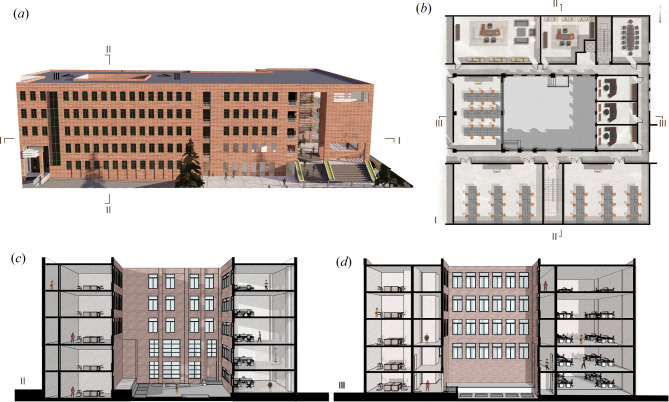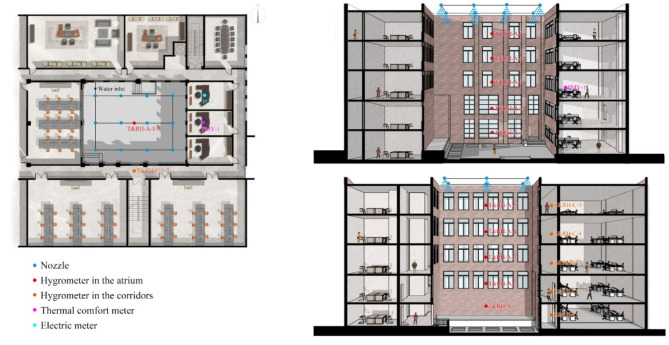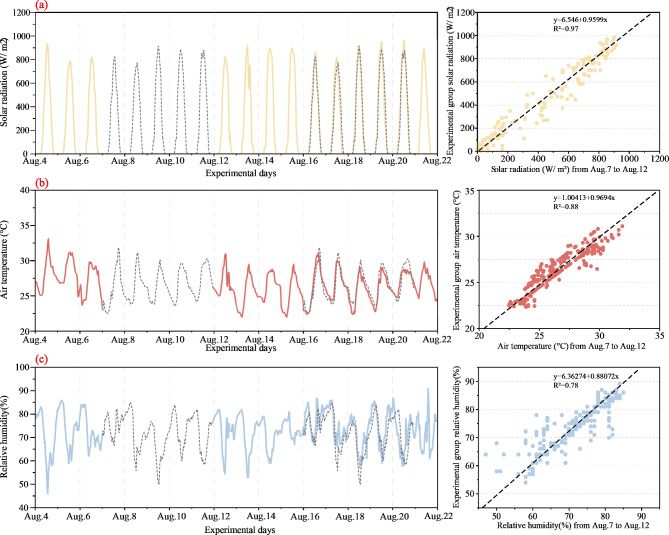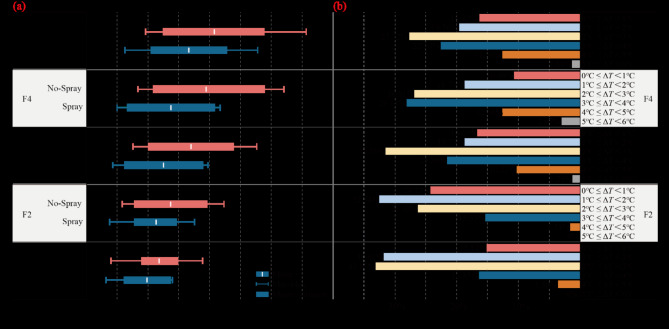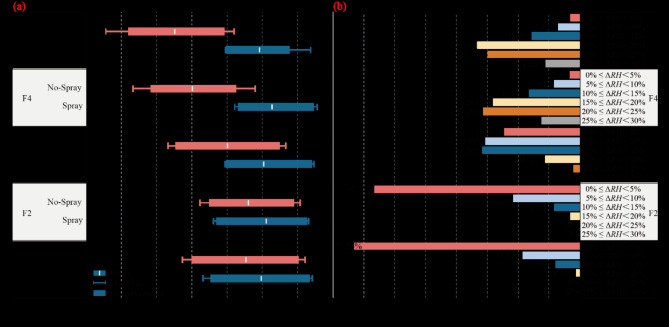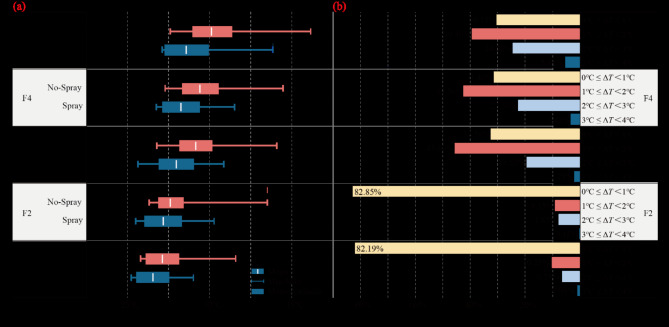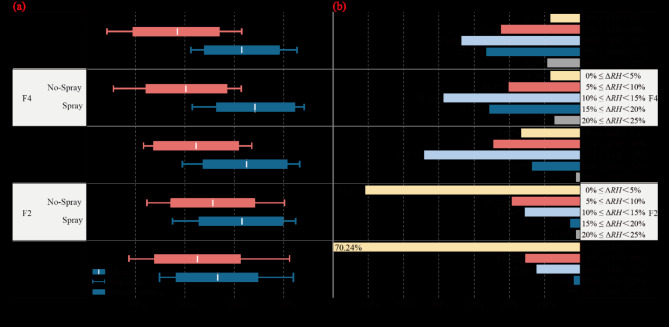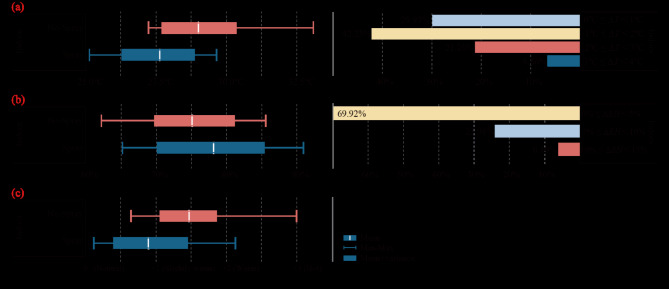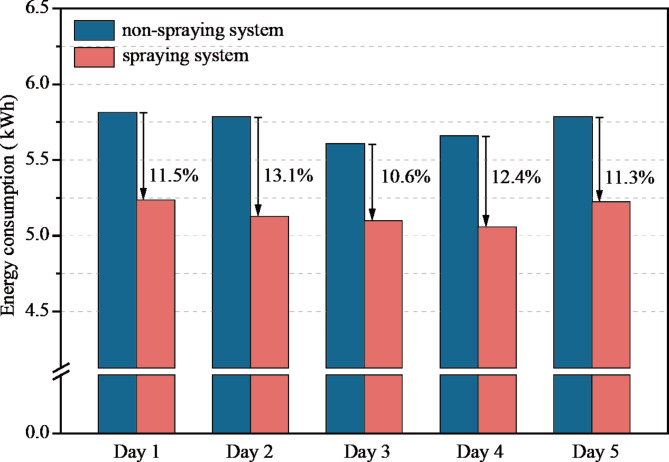Abstract
Outdoor atriums have recently been applied with increasing frequency for natural illumination, but they produce a harsh thermal environment easily in summer. Moreover, overheating of the outdoor atrium necessitates air-conditioning to moderate indoor thermal comfort. Simultaneously, the substantial heat emissions from air-conditioning outdoor units worsen the outdoor thermal environment, creating a vicious cycle. Traditional passive evaporative methods involving water and greenery, while capable of regulating the thermal environment, suffer from low evaporative efficiency and pose significant challenges. To improve thermal environment in outdoor atriums, the spray system was employed due to its high cooling efficiency, especially in open or semi-open spaces. In this study, a comparative experiment was conducted to evaluate the effectiveness of using a spray system for evaporative cooling in open outdoor spaces. Furthermore, employing high-efficiency evaporative cooling through spraying to disrupt the vicious cycle of indoor and outdoor thermal environments. The dual goals include regulating indoor and outdoor thermal conditions while also mitigating the local heat island effect. Temperature and humidity distribution within the atrium and adjacent hallways were monitored, along with the impact on air-conditioning operation consumption in neighboring offices. Results showed that the spray system significantly improved the thermal environment in the outdoor atrium, reducing the average and peak air temperatures by 0.94–2.83 °C and 2.92–5.21 °C, respectively. It also resulted in a drop in the average temperature by 0.56–1.62 °C and the peak temperature by 2.31–3.25 °C in adjacent hallways. This effectively eased the issue of overheating in these areas while raising the comfort level in adjacent office spaces. The predicted mean vote decreased from 1.46 to 0.87, indicating a significant improvement in thermal environment in neighboring offices. Furthermore, the daily energy consumption was reduced by 10.6–12.4% in neighboring offices. This study provided the valuable guidance for improving thermal environments within outdoor atrium.
Keywords: Thermal environment, Spray system, Outdoor atrium, Energy consumption, Office building
Subject terms: Civil engineering, Environmental sciences
Introduction
Energy and environment are two major challenges faced by mankind1,2. With the urbanization process, large individual buildings are increasingly prevalent3. In these buildings, atriums are widely employed as a common feature to enhance the lighting environment and natural ventilation4. As spaces for exchanging climate between indoor and outdoor environments, atriums create unique thermal environments that regulate indoor climates5. In high outdoor atriums, thermal stratification is significantly exacerbated by natural convection6. Furthermore, numerous air-conditioning units are installed on exterior walls near outdoor atriums. Consequently, driven by both air-conditioning heat dissipation and natural convection, the thermal environment in outdoor atriums tends to be poor, particularly in higher Sect7.
Regarding the thermal environment in atrium spaces, Holford and Hunt8 conducted a study on the impact of atrium geometry on natural ventilation. They developed a theoretical model to predict the steady stack-driven displacement flow and thermal stratification in the building. Aldawoud9 carried out a comprehensive investigation into the thermal performance of various atrium shapes and geometries in buildings, aiming to evaluate their influence on total energy consumption and identify optimal designs for energy-efficient atria. Wang et al.10 examined temperature distribution profiles in atriums with different section aspect ratios to optimize annual energy consumption. Ge et al.11 analyzed the effect of non-enclosed atriums on the surrounding thermal environment in shopping malls, revealing that glass ceilings exacerbated thermal stratification by 50%, while air infiltration from upper openings resulted in heat gain ranging from 94-213w/m2. Shaeri et al.12 explored how 12 different ceiling shapes influenced internal thermal comfort in Bushehr city, Iran, finding a significant correlation between predicted percentage of dissatisfied individuals and thermal environmental parameters.
Lu et al.13 investigated the thermal performance of atria in cold climates and emphasized the need for roof ventilation to prevent overheating, even in severe cold conditions. They also stressed the importance of strict regulations on air infiltration rates in atria due to significant heat loss through infiltration. Moosavi et al.14 examined passive cooling strategies for controlling atrium overheating in an office building located in Malaysia and found that implementing cross ventilation and appropriate inlet openings could improve indoor thermal conditions by reducing temperature and humidity levels.
The thermal and daylight performance of atriums and courtyards in hot climates were compared by Asfour15. It was concluded that both types have equivalent cooling and lighting loads. Buildings with a 30% window-wall ratio, equipped with shading devices, are the optimal choice between the two options. The effects of wind direction and openings on atrium ventilation were defined in a study conducted by Horran and Finn16. The analysis revealed that perpendicular winds to the openings result in the highest ventilation, while winds blowing at an angle of 135° have the least impact on ventilation. Consequently, reducing the area of openings would lead to a decrease in ventilation rates by 23% and 11%. Xu et al.17 investigated the thermal characteristics of the atrium space in a teaching building during winter. Their findings revealed a vertical temperature gradient of 0.49 °C/m and an indoor air temperature range of 8.22 °C. Liu et al.18 examined the impact of buoyancy-driven ventilation on buildings with atria, highlighting that optimizing the position and size of stack openings can enhance thermal comfort levels.
Based the above studies, the outdoor atrium’s thermal phenomena, particularly thermal stratification, significantly influence both surrounding rooms’ thermal environment and air-conditioning energy consumption. Therefore, it is imperative to improve the thermal environment of outdoor atrium to achieve favorable levels of thermal comfort. The spray system offers several advantages, making it a viable choice for enhancing the thermal environment in outdoor atriums due to its efficient evaporative cooling capabilities (Outdoor temperature reduction of 3.5 °C-8.2 °C19–21, methods and impacts, as well as high cost-effectiveness (spraying system in taxi waiting area costs only $16.43 per day)22,23.
Zhang et al.24 further reported that women and overweight individuals exhibited higher thermal sensitivity to the spray environment compared to men and underweight individuals. Meng et al.25 demonstrated that the suitable flow rate is 30 ml/min in Qingdao city. In a study conducted by Oh et al.26, a spray experiment was carried out in the city square, revealing that the thermal sensation rating transitioned from warm to neutral upon exposure. Furthermore, there was an observed decrease of 0.53 °C in mean skin temperature after spending 10 min within the spray environment. Chan et al.27 improved thermal comfort prediction by incorporating additional predictor variables into artificial neural network models, resulting in a significant performance enhancement. Abdullah et al.28 enhanced the indoor thermal environment within an atrium with a transparent envelope by implementing blinds and an evaporative spray. Yang et al.29 installed a misting system in an atrium with a glass ceiling to mitigate thermal conditions, effectively reducing surface temperature by 5-5.6 °C. The above studies proved that spraying cooling has a significant effect on human thermal comfort24,26,27, and verified the feasibility of spray evaporative cooling in Qingdao area25. Furthermore, the combination of spray evaporative cooling and building atrium can effectively change the indoor and outdoor thermal environment28,29. There is a possibility that integrating the spray system with an open building atrium can enhance both indoor and outdoor thermal environments, thereby improving overall comfort levels.
Therefore, it is proved that the spray system had the high cooling efficiency, especially in open or semi-open spaces, where the traditional air-conditioning system cannot operate efficiently.
The efficient cooling of the spray system in open or semi-open spaces becomes a potential method to address the thermal problems within the atrium, but there is the clear gap on the application of the spray system in outdoor atrium. Therefore, it is necessary to substantiate its efficiencies on the thermal environment improvement with the atrium.
To achieve this purpose, an experiment was conducted to compare the thermal environment in the atrium before and after implementing the spray system. The air temperature and relative humidity were mainly monitored in the atrium. The thermal environment improvement in the atrium can impact the thermal environment in adjacent hallways and neighboring offices, so indoor thermal conditions and air-conditioning energy consumption in adjacent hallways and neighboring offices also assessed. This study aims to evaluate how incorporating a mist spray system positively impacts improving the thermal environment within the atrium. Additionally, high-efficiency evaporative cooling is used to break the vicious cycle of indoor and outdoor thermal environments. The dual objective is to regulate the indoor and outdoor thermal conditions while mitigating the local heat island effect.
Methodology
Description of experimental platform
The experimental site was in the atrium of a five-story educational building in Qingdao city, China (120°37′N and 36°10′E). Figure 1a shows a photo of the experimental atrium and building model, while Fig. 1b,c,d give the three-level floor plan, East-west building section and North-south building section. The experimental building is about 17.8 m tall and covers an area of around 12,706.73 m2. It serves multiple purposes, including education, office work, and conducting experiments. The atrium measures 12.7 m (Length) × 15.28 m (Width) × 17.80 m (Height), with an opening roof connected directly to the outdoor environment. Spray nozzles were installed on the atrium roof at a height of 17.8 m. In this study, twelve spray locations were used at the top of the atrium as shown in Fig. 2, with each location spaced approximately four meters apart from adjacent ones. The spray system consists of a pump, nozzles, water pipes and fittings, and a control device; municipal tap water is used directly. Table 1 presents equipment parameters for the spray system. It was confirmed that all experiments in this study were performed in accordance with the relevant guidelines and regulations. The building selected for this experiment complies with the Chinese civil building design code, and the thermal conductivity of the wall of the composite insulation material of the building is 0.45 W/(m·K), and the thermal resistance of the wall is 2.1 m²·K/W. The thermal conductivity of the single-layer glass is 1.1 W/(m·K), and the transmittance coefficient is 0.6, and the ratio of the building’s windows to the walls is about 32.6%.
Fig. 1.
The schematic diagram of (a) building model, (b) Three-level floor plan, (c) East-west building section and (d) North-south building section. (Drawn by SketchUp Pro 2021 (21.0.339-64bit)30).
Fig. 2.
The schematic diagram of the measurement location in the atrium & the adjust hallway and the monitored offices on the third floor. (Drawn by SketchUp Pro 2021 (21.0.339-64bit)30).
Table 1.
The equipment parameters of the spray system.
| Component | Type | Specifications |
|---|---|---|
| Nozzle | N-3010 | Pressure: 6 MPa |
| Flow rate: 1.8 L/h | ||
| Droplet particle size: 0.3 mm | ||
| Spray pump | PC-2801 | Pressure: 6 MPa |
| Flow rate: 18 L/h | ||
| Power: 120 W |
Description of measurement location
The thermal environment in the atrium has the certain influence on the adjacent indoor environment, and as shown in Fig. 1b, there are the hallways and offices close to the atrium. Therefore, the thermal environment in the atrium, hallways and offices were monitored. Figure 2 also illustrates the schematic diagram of measurement locations in both the atrium and adjacent hallways as well as monitored offices on the third floor. To measure thermal environment distribution within these areas, five hygrometers (T&RH-A-1 ~ T&RH-A-5) were placed at level heights of 1.5 m, 4.8 m, 8.l m, 11.4 m and 14.7 m and five hygrometers (T&RH-C-1 ~ T&RH-C-5) were in the hallways under the same heights, which is 1.5 m above floors31. At the midpoint of each floor of the building, 1.5 m above the ground level, near the windows, becomes a critical point for heat exchange between indoor and outdoor air. This location is also near indoor hallway, which are usually pedestrianized areas. A position at 1.5 m, 4.8 m, 8.l m, 11.4 m and 14.7 m height (Building floor height 3.3 m) can represent the average height at which people breathe and more accurately reflect the effect of cooling on the human body25. Moreover, indoor thermal environment (PMV-1) is measured by a thermal comfort meter in a neighboring office under the natural condition at a height of 1.1 m above the floor, which is the appropriate measurement height for a human body in a seated office situation. The air-conditioning power consumption (PC-1) in another neighboring office is also tested by an electric meter. A solar radiometer was in the building roof to monitor the horizontal solar radiation intensity. Table 2 showed the equipment test parameters.
Table 2.
Meteorological parameter measuring range and accuracy of the instrument.
| Component | Type | Variable | Measuring range | Accuracy |
|---|---|---|---|---|
| Thermal comfort meter | JT-IAQ-50 | Air temperature | -20 ~ + 125 °C | ± 0.2 °C |
| Relative humidity | 0 ~ 100% | ± 3% | ||
| Wind speed | 0.05 ~ 5 m/s | ± 2% | ||
| Globe temperature | -20 ~ + 85 °C | ± 0.2 °C | ||
| Toprie data measuring instrument | TP1000 | Air temperature | -20 ~ + 70 °C | ± 0.2 °C |
| Relative humid | 0 ~ 100% | ± 3% | ||
| Solar radiometer | JTR05 | Solar radiance | 0 ~ 2000 W/m2 | ± 2% |
| The electric meter | SPM-10 A | Electric power | 0 ~ 4500 W | 0.01 W |
The study duration encompassed a total of 19 days, with all instrument data recorded at 10-minute intervals. Specific measurement points and data acquisition details are outlined as follows:
Thermal comfort meter instruments were utilized in offices adjacent to the outdoor atrium to measure temperature, relative humidity, wind speed, and globe temperature. One room per floor was selected, resulting in 5 measurement points with a total of 20 datasets.
Toprie Data measuring instruments were employed in hallways and atrium spaces to measure temperature and relative humidity, resulting in 10 measurement points with 20 datasets.
The electric meter was used to measure power consumption of the air-conditioning, with one measurement point per floor, resulting in 5 measurement points and 5 datasets.
Outdoor meteorological parameters were recorded using Toprie Data measuring instruments and a Solar radiometer to measure outdoor temperature, relative humidity, and solar radiation. This involved 1 measurement point with 3 datasets.
Therefore, the study encompassed a total of 21 measurement points, yielding 48 datasets. Daily data recording amounted to 6,912 entries, resulting in a total of 131,328 recorded data points throughout the experimental period.
Uncertainty analysis
Due to the uncertainties of the individual measuring instruments, errors in the experimental results are inevitable. The absolute error of air temperature measurement is 0.20 °C, which leads to the uncertainty of 2.70%, while the absolute errors are 0.51%, 2.00%, 2.00%, and 3.00% for the electric meter, relative humidity, Solar radiance, and wind speed according to Table 2, respectively. Combining with the accuracy parameters, the total uncertainty of the experimental system was calculated as from the following equation32.
 |
1 |
where UI is synthetic standard uncertainty for each instrument. The variables in Eq. (1) are the synthetic standard uncertainties for temperature, relative humidity, electric meter, solar radiation, and wind speed, respectively, and the value of this variable is calculated from the absolute error of each instrument.
Moreover, the space was devoid of high-intensity illumination and shaded by blinds during typical diurnal periods to mitigate the impact of the mean radiant temperature. Meanwhile, the discrepancy between the mean radiant temperature and the desired temperature was quantified in all test rooms prior to the experiment, with a mean difference of less than 0.5 °C. Accordingly, the mean radiant temperature was not assessed on a separate basis.
Results
The experiment was carried out between Aug. 4. and Aug. 21, 2022, with the spray system being activated from Aug. 14 to Aug. 22. Figure 3 illustrates the variations in outdoor air temperature, relative humidity, and solar radiation during the experimental period. Notably, comparable climate conditions were detected between Aug. 7–11 and Aug. 16–20. Consequently, the data from Aug. 7 to 11 served as a baseline to evaluate the spray system’s cooling efficiency during its operation from Aug. 14 to 22. Furthermore, based on fitting the data from Aug. 7–11 and Aug. 16–20, the R2 values for solar radiation, air temperature and relative humidity were 0.97, 0.88 and 0.78, respectively. This indicates that the selected outdoor meteorological parameters are similar and can be used for this experiment.
Fig. 3.
Variation of (a) outdoor air temperature, (b) relative humidity, and (c) solar radiation during the experimental period.
Throughout these times, the outdoor air temperature fluctuated between 22.5 °C and 31.9 °C, with an average of 26.5 °C. The relative humidity also varied from 54 to 85%, with an average of 71.8%. The peak solar radiation was as high as 914.1 W/m2. The outdoor meteorological parameters are in accordance with the summer meteorological parameters of Qingdao area (high humidity area). Additionally, the spray system was operational from 8:00 AM to 6:00 PM. Taking into account the spray system’s impact on the entire day, the comparison of experimental data was conducted over the full duration. Since the experimental period coincided with the summer vacation in Chinese universities, any human interference was minimal and could be disregarded.
Air temperature and relative humidity in the outdoor atrium
The spray system was situated at the roof of the studied building. Figure 4a displays the comparison of air temperatures across each layer following spray application. It’s evident that the installation of the spray system substantially cooled the outdoor air temperatures, particularly in the third, fourth, and fifth layers, where temperatures decreased by 2.03 °C to 2.75 °C. The most significant drop in peak air temperature was observed in the fourth layer, with a reduction as high as 5.21 °C, while the average decrease in peak temperatures was approximately 3.70 °C. This reduction helped mitigate excessive heat in the outdoor atrium’s thermal environment. Additionally, a notable thermal stratification used to occur due to natural convection and heat dissipation from the air-conditioning outdoor unit, but the spray system effectively reduced this stratification from 0.37 °C/m to 0.28 °C/m.
Fig. 4.
Comparison of (a) air temperature and (b) its distribution of temperature difference in the outdoor atrium.
Figure 4b shows the temperature difference distribution within the outdoor atrium area: ranging primarily between 1 and 3 °C for the two lower floors and 2–4 °C for the three upper floors, owing to the spray system’s placement atop the fifth floor. The proportions with a temperature difference of 5–6 °C could respectively reach up to 1.28%, 2.97%, and 1.23% in the third, fourth, and fifth layers. Compared with the cooling effect of plant transpiration in the outdoor atrium, the spray system can turn water into smaller and easier to evaporate small droplets, accelerating the heat exchange between droplets and air, and then a rapid cooling effect occurs. Furthermore, due to the air convection between the upper and lower levels of the outdoor atrium, the cooling effect of the spray system on the fourth and fifth floors can be transferred to the first and second floors, realizing the cooling effect on the whole outdoor atrium.
The relative humidities in each layer of the outdoor atrium were compared before and after spraying in Fig. 5a. Prior to the spray system, the relative humidity decreased with altitude due to the thermal stratification and plant transpiration on the ground. After implementing the spray system, there was a significant increase in relative humidity, particularly in the fourth and fifth layers, with average increases of 22.30% and 22.91%, respectively. The addition of the spray system improved uniformity of relative humidities vertically.
Fig. 5.
Comparison of (a) relative humidity and (b) its distribution of humidity difference in the outdoor atrium.
Figure 5b also illustrates the distribution of relative humidity differences within the outdoor atrium. The humidity difference mainly ranged from 0 to 5% on two bottom floors, 5-15% on the third floor, and 15-30% on two top floors. This phenomenon is attributed to the location of the spraying system on the fifth floor. Compared to the increase in relative humidity due to plant transpiration, there are two components to the increase in relative humidity after spraying. These include the increase in absolute humidity in the air due to the evaporation of droplets from heat absorption to water vapor, and the increase in relative humidity due to the decrease in the vapor saturation pressure of the air as a result of the decrease in temperature. Furthermore, due to the high concentration of water vapor in the air of the fourth and fifth floors will be diffused with the low concentration of water vapor in the first and second floors, resulting in an increase in the relative humidity of the first and second floors as well.
The air temperature and relative humidity in the hallway near the outdoor atrium
The adjacent space benefits greatly from the presence of an outdoor atrium, which plays a crucial role in moderating the thermal environment. The hallway serves as a direct link to this atrium, facilitating a seamless exchange of air.
The air temperatures in each layer of the hallway were compared before and after the spraying, as shown in Fig. 6a. It is evident that the addition of the spraying system significantly reduced the air temperature in the hallway, particularly in the third, fourth, and fifth layers. The values in these three layers decreased by 1.20–1.62 °C, which was lower than those observed in the outer atrium. On average, the peak air temperature was reduced by 2.87 °C. Additionally, there was a noticeable thermal stratification with thermal stratification strengths of 0.25 °C/m and 0.16 °C/m before and after spraying respectively. Compared to the first and second floors, the third to fifth floors are directly affected by the spray system, which leads to a direct heat exchange between the indoor and outdoor air and a significant drop in air temperature. In addition, the air temperature varies with height, resulting in a large temperature difference between the upper floors and the lower floors.
Fig. 6.
Comparison of (a) air temperature and (b) its distribution of temperature difference in the hallway.
The temperature difference in the hallway was lower than that in the outdoor atrium, as shown in Fig. 6b. The distribution of temperature difference mainly focused on 0–1 °C in the bottom floors and 1–3 °C in the top floors. This phenomenon is attributed to the spraying system on the fifth floor, which resulted in a temperature difference of up to 5–6 °C percentages of 1.28%, 2.97%, and 1.23% for the third, fourth, and fifth layers respectively.
The relative humidities in each layer of the hallway were compared before and after spraying in Fig. 7a. It is evident that the spray system significantly increased the relative humidities in each layer, particularly on the three top floors, with average increases of 10.31%, 14.00%, and 13.31% on the third, fourth, and fifth floors respectively. Figure 7b also illustrates the distribution of relative humidity differences in the hallway, showing a focus on ranges of 0-5% on two bottom floors, 5-15% on the third floor, and 10-20% on two top floors. Compared to the lower floors, the high concentration of water vapor in the upper floors is easily diffused with the low concentration of water vapor indoors, resulting in high relative humidity in the upper floors. Additionally, the rapid diffusion of water vapor in the air results in a lower relative humidity at the first floor of the outdoor atrium, which also results in a lower indoor exposure.
Fig. 7.
Comparison of (a) relative humidity and (b) its distribution of relative humidity difference in the hallway.
The air temperature and relative humidity in offices near the outdoor atrium
The outdoor atrium also affected the thermal environment in the nearby offices. An office on the third floor (shown in Fig. 2) was selected, and its doors and windows were closed.
Figure 8 compares air temperature, relative humidity, and the predicted mean vote (PMV) in offices before and after implementing the spraying system. PMV was gained by the thermal comfort meter (JT-IAQ-50)33. Preliminary research indicates that during the summer months, individuals primarily engage in sedentary activities within office environments, such as desk work and document handling. These activities are typically conducted while wearing clothing items such as trousers, shirts, lightweight pants, socks, and shoes. Accordingly, the baseline metabolic rate for individuals engaged in this occupational activity is established at 1.2, with a heat dissipation rate of 60 W/m² for the specified activity level and a clothing thermal resistance of 0.6. The Fanger’s PMV-PPD model34 was employed to calculate the PMV during the study period using a formula based on environmental parameters, set metabolic values, heat dissipation rates, and clothing thermal resistance.
Fig. 8.
Comparison of (a) air temperature, (b) relative humidity and (c) predicted mean vote in offices.
As shown in Fig. 8, indoor air temperatures decreased by an average of 1.41 °C and a peak of 3.45 °C, with a main temperature difference of 1–2 °C. The average and peak values of relative humidity decreased by 2.69% and 5.41%, respectively, with a main humidity difference less than 5%. Correspondingly, due to the spray system, the predicted mean vote reduced from 1.46 to 0.87, indicating significant improvement in the indoor thermal environment due to the enhanced thermal conditions created by the spraying system in the outdoor atrium. Calculations based on Fanger’s PMV-PPD model35 show that the PPD was reduced by 21% from 58%, which indicates that the use of misting systems in outdoor atriums effectively improves the indoor thermal environment. Furthermore, existing research indicates that droplets also exert a certain impact on solar radiation, resulting in a slight reduction in indoor solar radiation and an additional enhancement in bodily thermal comfort36.
The energy consumption of air-conditioning in offices near the outdoor atrium
The influence of the spraying system on air-conditioning energy consumption in offices was evaluated by selecting an office surrounding the outdoor atrium (In Fig. 2) with a set air temperature of 25 °C and closed doors and windows. In the studied offices, there are the air conditioners with the operating power of 1000w. Figure 9 compares air-conditioning energy consumption in five days before and after the spraying system installation, showing a noticeable reduction in energy usage due to the spray system’s ability to lower ambient temperature within the outdoor atrium. This facilitates heat dissipation from the air-conditioning outdoor unit under lower ambient temperatures, resulting in a daily energy consumption reduction of 10.6-12.4%. Due to the reduction of air temperature at both the inlet and outlet al.ong with the evaporating droplets, it reinforced the heat dissipation of the air-conditioning condenser. This enabled more refrigerant to complete condensation within the same timeframe, thereby lowering the power consumption during compressor operation37. With enhanced heat rejection from the condenser achieved through evaporative spray cooling of air streams at multiple points, the compressor could obtain heat more efficiently and rapidly to relieve its working load under high ambient conditions38. These findings highlight that not only does the spray system improve thermal conditions within the outdoor atrium, but it also effectively reduces air-conditioning energy usage in surrounding office spaces.
Fig. 9.
Comparison of air-conditioning energy consumption in offices near the open Atrium.
This study merely conducted energy consumption measurements and feasibility validation in one room per floor of the building, without considering all rooms adjacent to outdoor atrium within the building. The above conclusions demonstrate a significant reduction in localized energy consumption due to the spraying system. Future research will comprehensively assess the energy consumption of all air conditioning systems and spraying systems within the building to ascertain the impact of spraying systems on the building’s energy consumption.
Discussion
Compared to the study of the cooling of the artium by means of a spray system (maximum cooling of 2.06 °C)39, the difference in the cooling effect of the interior could be due to the area of the openable of the window, which in the present study could be up to 3 °C due to the evaporative cooling of the liquid droplets. This difference leads to air convection and heat exchange between the indoor and outdoor air, which in turn affects the cooling effect. Moreover, wind speed and wind angle can have a significant effect on the cooling effect and mitigate thermal stratification to some extent40.
The composite spray system in the outdoor unit reduces the energy consumption of air conditioning by 13.9-37.3% compared to the existing studies7, and the maximum energy saving in this study is 13%. The direct combination of the spray equipment with the air-conditioning outdoor unit can reduce the energy consumption by 37.3% by allowing the cooled air and droplets to exchange heat directly with the condenser. However, since the droplets first cool the air in the outdoor atrium, the cooled air improves the efficiency of the condenser, which in turn reduces the energy consumption generated by the compressor. The effect of this process on the condenser of the air-conditioning outdoor unit is indirect, and therefore the energy saving efficiency will be lower than that of the existing studies. Therefore, in subsequent studies of outdoor atriums, the energy-saving effect can be enhanced by adding baffles to capture air41.
Furthermore, similar to the findings of other researchers, the significant improvement of the PMV reduction from 1.46 to 0.87 indicates the improvement of the thermal comfort of the room by the external fogging device. The shading effect of the droplet mist layer can reduce the solar radiation transmittance by 9.0–12.3% compared to the cooling effect of the air conditioning system, which effectively improves the indoor thermal environment42.
This method uses a spray system to mitigate the thermal environment of outdoor atriums. It has a high cooling efficiency, significantly reduces the local air temperature, significantly reduces the energy consumption of air-conditioning systems, has a low construction investment and a long service life. The method can be widely applied in summer to spaces such as building atriums and enclosed courtyards. In these places, a local heat island effect is formed due to poor air convection and heavy heat dissipation from the outdoor air-conditioning, which affects indoor and outdoor thermal comfort.
Conclusions
In this study, the spray system was utilized to enhance the thermal environment in the outdoor atrium and its surrounding spaces. To assess the positive impact of the spray system, air temperature and relative humidity were tested within the atrium and adjacent areas, while also evaluating indoor thermal conditions and air-conditioning energy consumption in neighboring offices. The key findings are as follows:
The spray system effectively enhances the thermal environment in the outdoor atrium by reducing average air temperature by 0.94–2.83 °C and peak air temperature by 2.92–5.21 °C, thereby mitigating thermal stratification from 0.37 °C/m to 0.28 °C/m. Additionally, it increases relative humidity by an average of 12.89%.
The spray system implemented in the outdoor atrium positively contributes to improving the thermal environment in hallways as well, with an average reduction of 0.56–1.62 °C in air temperature and a decrease of approximately 2.31–3.25 °C in peak temperatures, effectively alleviating overheating issues while maintaining comfort levels intact. Furthermore, there is an average increase of relative humidity by 9.82%.
In the office adjacent to the outdoor atrium, indoor air temperature was reduced by an average of 1.41 °C with the peak value decreased by 3.45 °C, while relative humidity increased by an average of 2.69% and 5.41% respectively. The predicted mean vote reduced from 1.46 to 0.87, indicating a significant improvement in the indoor thermal environment. The daily energy consumption was lowered by 10.6-12.4%.
The experiments have demonstrated the potential of the spray system in improving the thermal environment in outdoor atrium and its adjacent offices. However, there are the certain limitations, due to the local climate condition and the special spray system. The variation in climate condition must potentially affect the results and the spray system may had the promotion potential. Further research under a wider range of climate and equipment conditions would be required to generalize the results.
Author contributions
Conceptualization, N.D., J.Y.S., F.P., and X.M.; methodology, N.D. and X.M.; formal analysis, J.Y.S. and X.M.; investigation, N.D., J.Y.S., F.P., and X.M.; data curation, N.D. and X.M.; writing—original draft preparation, N.D.; writing—review and editing, N.D. and X.M.; supervision, X.M.; project administration, N.D., and X.M.;
Data availability
All data generated or analysed during this study are included in this published article.
Declarations
Competing interests
The authors declare no competing interests.
Footnotes
Publisher’s note
Springer Nature remains neutral with regard to jurisdictional claims in published maps and institutional affiliations.
References
- 1.Liu, S. H., Ge, W. Y. & Meng, X. Influence of the shading nets on indoor thermal environment and air-conditioning energy consumption in lightweight buildings. Energy Rep.11, 4515–4521 (2024). [Google Scholar]
- 2.Meng, X. Analysis on rotation timing of dynamic rotating latent-energy-storage envelope (RLESE). Dev. Built Environ.19, 100498 (2024). [Google Scholar]
- 3.Meng, X. Influence of air-conditioning intermittent operation on the cooling load from Opaque envelopes in residences. Case Stud. Therm. Eng.58, 104393 (2024). [Google Scholar]
- 4.Zhao, Y. J., Zhao, K. & Lu, J. Ge. Investigating the temperature distribution of non-enclosed atriums with air infiltration in winter. Build. Environ.236, 110256 (2023). [Google Scholar]
- 5.Beyraghshamshir, M. & Sarkardehei, E. A comparison of the cooling and heating performance of two passive systems of central courtyards and atriums at an elementary school in Yazd City. Sol. Energy252, 156–162 (2023). [Google Scholar]
- 6.Dai, B. L., Tong, Y., Hu, Q. & Chen, Z. Characteristics of thermal stratification and its effects on HVAC energy consumption for an atrium building in south China. Energy249, 123425 (2022). [Google Scholar]
- 7.Ge, L. M., Gao, Y. & Meng, X. Employing the spray system to alleviate the thermal action of air-conditioning in summer. Case Stud. Therm. Eng.55, 104133 (2024). [Google Scholar]
- 8.Holford, J. M. & Hunt, G. R. Fundamental atrium design for natural ventilation. Build. Environ.38, 409–426 (2003). [Google Scholar]
- 9.Aldawoud, A. The influence of the atrium geometry on the building energy performance. Energy Build.57, 1–5 (2013). [Google Scholar]
- 10.Wang, L., Huang, Q., Zhang, Q., Xu, H. & Yuen, R. K. K. Role of atrium geometry in building energy consumption: The case of a fully air-conditioned enclosed atrium in cold climates, China. Energy Build.. 151, 228–241 (2017). [Google Scholar]
- 11.Ge, J., Zhao, Y. J. & Zhao, K. Impact of a non-enclosed atrium on the surrounding thermal environment in shopping malls. J. Build. Eng.35, 101981 (2021). [Google Scholar]
- 12.Shaeri, J., Mahdavinejad, M., Vakilinejad, R., Bazazzadeh, H. & Monfared, M. Effects of sea-breeze natural ventilation on thermal comfort in low-rise buildings with diverse atrium roof shapes in BWh regions. Case Stud. Therm. Eng.41, 102638 (2023). [Google Scholar]
- 13.Lu, Y., Xiang, Y., Chen, G., Wu, Y. & Sun, C. Liu. Summer dynamic thermal environment for isolated atrium in the severe cold region: On-site measurement and numerical simulation. Appl. Therm. Eng.160, 114108 (2019). [Google Scholar]
- 14.Moosavi, L., Mahyuddin, N. & Ghafar, N. Atrium cooling performance in a low energy office building in the Tropics, a field study. Build. Environ.94, 384–394 (2015). [Google Scholar]
- 15.Asfour, O. S. A comparison between the daylighting and energy performance of courtyard and atrium buildings considering the hot climate of Saudi Arabia. J. Build. Eng.30, 101299 (2020). [Google Scholar]
- 16.Horan, J. M. & Finn, D. P. Sensitivity of air change rates in a naturally ventilated atrium space subject to variations in external wind speed and direction. Energy Build.40, 1577–1585 (2008). [Google Scholar]
- 17.Xu, C. et al. Study on winter thermal environmental characteristics of the atrium space of teaching building in China’s cold region. J. Build. Eng.67, 105978 (2023). [Google Scholar]
- 18.Liu, P. C., Lin, H. T. & Chou, J. H. Evaluation of buoyancy-driven ventilation in atrium buildings using computational fluid dynamics and reduced-scale air model. Build. Environ.44, 1970–1979 (2009). [Google Scholar]
- 19.Huang, C. et al. Yang. The research and application of spray cooling technology in Shanghai Expo. Appl. Therm. Eng.31(17–18), 3726–3735 (2011). [Google Scholar]
- 20.Ulpiani, G., Di Giuseppe, E., Di Perna, C. & D’Orazio, M. Zinzi. Thermal comfort improvement in urban spaces with water spray systems: Field measurements and survey. Build. Environ.156, 46–61 (2019). [Google Scholar]
- 21.Ulpiani, G. & di Perna, C. Zinzi. Water nebulization to counteract urban overheating: development and experimental test of a smart logic to maximize energy efficiency and outdoor environmental quality. Appl. Energy. 239, 1091–1113 (2019). [Google Scholar]
- 22.Zhang, Y. Feasibility Study and Application of Mist Cooling System for Taxi Passenger Queuing Area in Hongqiao Airport Terminal 2. Shanghai Airports (16th series) Ed. Shanghai Hongqiao International Airport Company Field Management Department 44–48 (2013).
- 23.Meng, X., Meng, L., Gao, Y. & Li, H. R. A comprehensive review on the spray cooling system employed to improve the summer thermal environment: Application efficiency, impact factors, and performance improvement. Build. Environ.217, 109065 (2022). [Google Scholar]
- 24.Zhang, M., Xu, C. B., Meng, L. & Meng, X. Outdoor comfort level improvement in the traffic waiting areas by using a mist spray system: An experiment and questionnaire study. Sustain. Cities Soc.71, 102973 (2021). [Google Scholar]
- 25.Meng, L., Gao, Y. & Meng, X. Experimental studies on spray flow rate optimization to improve outdoor thermal environment and its climate correlation analysis. Build. Environ.224, 109561 (2022). [Google Scholar]
- 26.Oh, W., Ooka, R., Nakano, J., Kikumoto, H. & Ogawa, O. Environmental index for evaluating thermal sensations in a mist spraying environment. Build. Environ.161, 106219 (2019). [Google Scholar]
- 27.Chan, S. Y. & Chau, C. K. Development of artificial neural network models for predicting thermal comfort evaluation in urban parks in summer and winter. Build. Environ.164, 106364 (2019). [Google Scholar]
- 28.Abdullah, A. H., Meng, Q. L., Zhao, L. H. & Wang, F. Field study on indoor thermal environment in an atrium in tropical climates. Build. Environ.44, 431–436 (2009). [Google Scholar]
- 29.Yang, C., Mu, J. & Meng, Q. Test and analysis of thermal environment of building lighting atrium spray cooling. Build. Energy Effi.47, 50–55 (2019). [Google Scholar]
- 30.https://help.sketchup.com/zh-CN/downloading-older-versions
- 31.Liu, F. D., Yan, L. Y. & Meng, X. A review on indoor green plants employed to improve indoor environment. J. Build. Eng.53, 104542 (2022). [Google Scholar]
- 32.Meng, X. Thermal performance assessment of the dynamic rotating latent-energy-storage envelope (DRLESE) during winter. Case Stud. Therm. Eng.60, 104671 (2024). [Google Scholar]
- 33.Hu, C. X., Wang, Z. H., Bo, R. F., Li, C. Y. & Meng, X. Effect of the cooling clothing integrating with phase change material on the thermal comfort of healthcare workers with personal protective equipment during the COVID-19. Case Stud. Therm. Eng.41, 102725 (2023). [Google Scholar]
- 34.Heidarinejad, G., Moghaddam, M. R. A. & Pasdarshahri, H. Enhancing. COP of an air-cooled chiller with integrating a water mist system to its condenser: Investigating the effect of spray nozzle orientation. Int. J. Therm. Sci.137, 508–525 (2019). [Google Scholar]
- 35.Fanger, P. O. Thermal Comfort. Analysis and Applications in Environmental Engineering 244 (1970).
- 36.Saneinejad, S., Moonen, P. & Carmeliet, J. Comparative assessment of various heat island mitigation measures. Build. Environ.73, 162–170 (2014). [Google Scholar]
- 37.Yang, H., Pei, N., Fan, M., Liu, L. & Wang, D. Experimental study on an air-cooled air conditioning unit with spray evaporative cooling system. Int. J. Refrig.131, 645–656 (2021). [Google Scholar]
- 38.Sharma, N. & Singh, J. Study and optimization of performance parameters of air conditioner by using waste water of water-cooler. Int. J. Emerg. Technol. Adv. Eng.4, 513–518 (2014). [Google Scholar]
- 39.Sun, H. et al. Numerical investigation of evaporative cooling strategies on the aero-thermal performance of courtyard buildings in hot-dry climates. Build. Environ.258, 111588 (2024). [Google Scholar]
- 40.Sharples, S. & Bensalem, R. Airflow in courtyard and atrium buildings in the urban environment: A wind tunnel study. Sol. Energy. 70(3), 237–244 (2001). [Google Scholar]
- 41.Foroozesh, J. et al. CFD modeling of the building integrated with a novel design of a one-sided wind-catcher with water spray: Focus on thermal comfort. Sustain. Energy Technol. Assess.53, 102736 (2022). [Google Scholar]
- 42.Yang, C., Mu, J. & Meng, Q. L. Thermal environment testing and analysis of spray cooling thermal environment in building light atrium. Build. Energy Effic.47(10), 50–55 (2019) (in Chinese). [Google Scholar]
Associated Data
This section collects any data citations, data availability statements, or supplementary materials included in this article.
Data Availability Statement
All data generated or analysed during this study are included in this published article.



